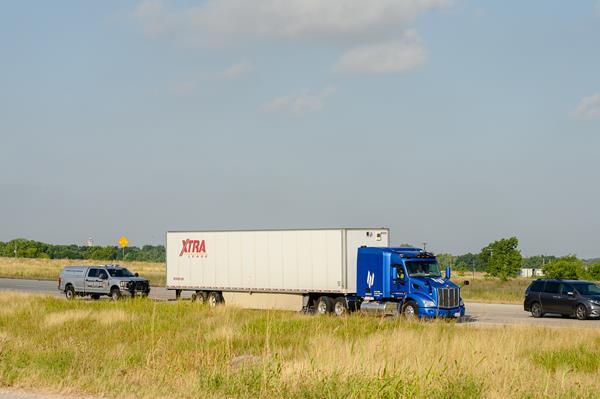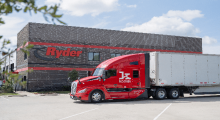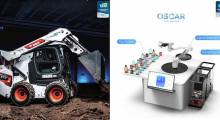How will self-driving trucks interact with police? Embark Trucks Inc. last week announced that it has completed a public demonstration of its emergency vehicle-interaction capability. The company built communication protocols and standard operating procedures between autonomous trucks and law enforcement officers.
Embark worked with the Texas Department of Public Safety (Texas DPS) and the Travis County Sheriff's Office (TCSO) to enable Embark-powered trucks to identify and stop for law enforcement vehicles. It claimed that its demonstration was the first one ever of police pulling over a self-driving truck for a routine traffic stop on a public highway.
“The ability to engage safely in emergency vehicle interactions is necessary to operate an autonomous vehicle on public roads,” stated Emily Warren, head of public policy at Embark Trucks. “Law enforcement always needs to be able to stop a commercial vehicle—autonomous or not—to ensure compliance with the law. This capability was designed to work seamlessly within existing law enforcement workflows, without requiring new training or technology investment by first responders.”
Embark achieves milestones
Since 2016, Embark Technology Inc. has been building software for autonomous trucks. The San Francisco-based company said it is focused on improving the safety, efficiency, and sustainability of the nearly $730 billion-a-year trucking market.
Embark has partnered with some of the largest shippers and carriers in the U.S. It raised $614 million through a special-purpose acquisition company (SPAC) merger in June 2022.
The company's technical capabilities roadmap specifies 16 requirements for commercial deployment of autonomous trucks in the U.S. Sunbelt (see below). With the emergency vehicle interaction capability demonstration, Embark said it has now achieved 12 of the technical milestones.
“We’re actively working on evasive and emergency maneuver testing, a capability we expect to accomplish by the end of 2022,” Warren told Robotics 24/7. “We’re also working with public and private-sector stakeholders on developing innovative processes to handle inspections and roadside visibility requirements for autonomous trucks.
Embark's successful demonstration coincided with intensifying scrutiny of autonomous vehicle safety after incidents involving TuSimple, Tesla, and Cruise. How is the company working to earn public confidence?
“Our goal is to execute against our go-to-market timeline and complete our capabilities roadmap with safety as our top priority,” replied Warren. “We are planning to achieve our remaining capabilities and begin driver out testing in 2023, allowing us to begin commercializing the Embark Driver in 2024.”
“Our decision to move forward with driver out operations on that timeline will be based on a rigorous determination that the system is prepared to operate safely without a human driver present,” she said.
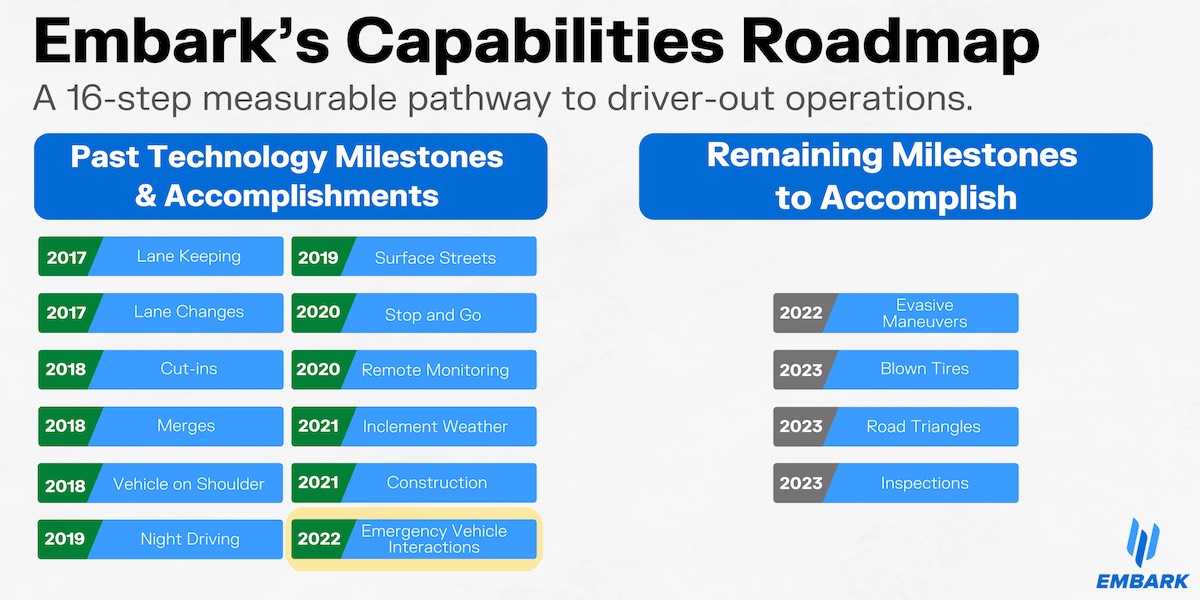
Technology to enable trucks to communicate
Embark said its engineering breakthrough involved two key components. First, its engineering team built the technical functionality for the capability. This included training Embark-powered trucks to identify emergency vehicles via lights and other cues and then respond accordingly by pulling over safely onto highway shoulders.
Second, Embark developed a procedure with input from Texas DPS and TCSO for any law enforcement officer to safely stop, approach, and receive information from an autonomous truck intuitively and without any additional equipment.
“Texas DPS and the Travis County Sheriff's Office highlighted the importance of creating a law enforcement interaction procedure that doesn’t require new investment, technology, or training by first responders,” explained Warren. “These agencies offered advice on what documentation needs to be readily available and easily accessible.
“They also provided important information about how commercial vehicle pullovers take place, including how a law enforcement vehicle approaches from behind, when it activates its lights, and more, informing how we trained our perception stack to identify law enforcement vehicles,” she said.
Warren added that Embark used the input to design its technology and procedure to do the following:
- Be broadly accessible to all law enforcement agencies without additional equipment, investment, or training
- Be equivalent to a conventional traffic stop in terms of availability of information and documentation
- Provide certainty to law enforcement officers regarding the safety of approaching the vehicle.
Commercial deployments may include visual cues and information to signal to law enforcement and other first responders that an Embark-powered truck is an autonomous vehicle and has come to a safe stop with no risk of restarting unexpectedly, the company said.
Embark plans to provide an externally accessible lockbox containing information such as registration and bills of lading, as well as a toll-free number for officers to contact an Embark Guardian support technician. It said these features are part of a comprehensive process for Embark-powered trucks to assist and comply with law enforcement requests, just as a human-driven truck would in similar situations.
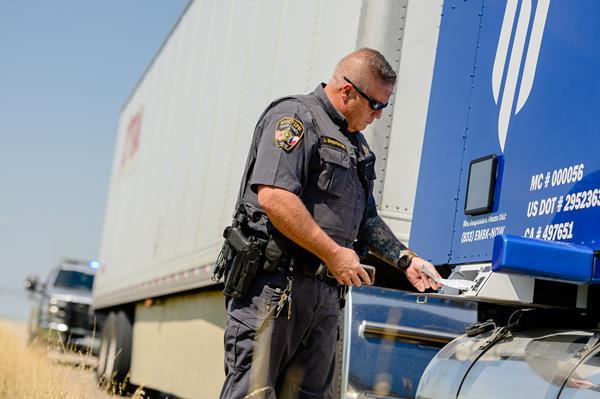
Test demonstrates safe approach
To develop the new capability, Embark, TCSO, and Texas DPS collected data and conducted testing from April to June that included closed-course activity at the Texas A&M University RELLIS Campus test track as well as public road demonstrations.
Embark’s demonstration took place in late June on Texas State Highway 130 near Austin. Deputies from the TCSO’s Commercial Vehicle Enforcement division followed an Embark-powered truck along a designated route and successfully completed a traffic stop of the Embark truck.
How will a self-driving truck know the request to pull over is legitimate?
“Any pullover request will alert our remote Guardian support technicians who monitor the trucks on their hauls,” replied Warren. “The Guardian support technician will be able to identify false positives or deceptive behavior and confirm a pullover request. They can then call the appropriate jurisdiction and easily confirm whether or not the officer is authentic.”
A deputy was able to confirm the truck was safe to approach via an external status display on the side of the truck. He then walked through the procedure of accessing the truck’s documentation via an external lockbox. The deputy used a code that would be provided by a remote Embark Guardian support technician.
The demonstration concluded after the deputy completed his traffic stop and followed the truck as it re-entered highway traffic. Embark published a white paper detailing this procedure and how it can be replicated in other jurisdictions, but it is not currently planning to expand testing.
“We’re not currently planning demonstrations in other states, though we have also worked with the California Highway Patrol to solicit input on this emergency vehicle interaction procedure,” Warren said. “As we commercialize and scale our technology, we hope this procedure can provide a template for law enforcement interaction for the broader autonomous truck industry and law enforcement communities across North America.”
About the Author
Follow Robotics 24/7 on Linkedin
Article topics
Email Sign Up

